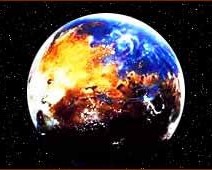 |
| What We Know About the Red Planet | ||||
| History | Water | Ice | Air | Canals |
| Seasons | Mountains | Rocks | SandDunes | Rift Valley |
| Moons | Dust Storms | Stats | Closest | Kid Pix |
| Lunar | Movies | Life Search | Wanted | Exploring Mars |
A thin carbon dioxide atmosphere:
Breathing the Air on Mars
RECENT DEVELOPMENTS: MARS EXPLORATION ROVERS MARS CLOSEST TO EARTH IN 59,619 YEARS
Astronomers, using telescopes with spectrographic measuring equipment, have found a thin atmosphere, mostly carbon dioxide, around Mars.
As far back as 1940 they knew oxygen and water vapor were extremely rare around Mars. The exact composition of the atmosphere, just like the true nature of the Martian surface, only became known when interplanetary space probes from Earth began to examine the planet at close range.
- The spacecraft found nitrogen, argon and small traces of oxygen and water vapor. To be precise, the atmosphere around Mars is 95 percent carbon dioxide, 3 percent nitrogen and 2 percent argon.
- Atmospheric pressure was measured at 7.5 millibars. That compares with 1,000 millibars on Earth at sea level.
Learn more: Human Exploration of Mars:
There have been three stages of exploration so farFlybys:
Probes fly by Mars taking pictures Orbiters:
Spacecraft fly into orbit above MarsLanders and Rovers:
- Orbiters
- Mariner 8-9
- Viking 1-2
- Mars Observer
- Mars Climate Orbiter
- Mars Global Surveyor
- Mars Global Surveyor home
- 2001 Mars Odyssey
- 2001 Mars Odyssey home
- Mars Express
- Mars Express home
- Mars Reconnaissance Orbiter 2005
- Mars Reconnaissance Orbiter home
Landers and rovers drop to the surfaceSand dunes: Dust Storms: Air: Carbon Dioxide: Outflow Channels: Valley Networks: Rift Valley: Ice: Ice caps: Frost: Water: Artesian Water: Mars Weather: Mars Photo Galleries: Planet features: Canals: Rocks: Mountains: Dating and aging: Seasons:
